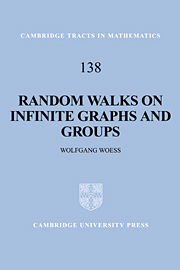Chapter IV - An introduction to topological boundary theory
Published online by Cambridge University Press: 22 September 2009
Summary
This final chapter is devoted to studying the interplay between the spatial behaviour of random walks, harmonic functions, and compactifications of the state space. The word “topological” in the title is thought of as opposed to “measure theoretic”. This means that the rich and deep theory of the Poisson boundary, related entropy methods and the weak Liouville property (constantness of bounded harmonic functions) will be touched only marginally.
Let X be a separable metric space (typically a graph with its integervalued distance). By a compactification of X we shall always mean a compact Hausdorff space with countable base of the topology, containing X, such that the inclusion X → is a homeomorphism, and such that X is open and dense in. Therefore is metrizable, and the boundary ϑX = \ X is compact. Our way of thinking is that the compactification has a “natural” description in terms of the geometry of X, prior to considering random walks. We then consider a transient random walk Zn on X with transition matrix P and look for suitable adaptedness conditions which allow us to answer the following questions.
(A) Convergence to the boundary. Does there exist a ϑX-valued random variable Z∞ such that in the -topology, Zn → Z∞ almost surely (ℙx) for every x?
(B) Dirichlet problem at infinity. Does every continuous function ϑX → ℝ admit a continuous extension to which is harmonic on X?
- Type
- Chapter
- Information
- Random Walks on Infinite Graphs and Groups , pp. 220 - 314Publisher: Cambridge University PressPrint publication year: 2000



